Some of the links in this post may be affiliate links.
Monstera deliciosa care is easier than you think! This post is the ultimate guide on growing Monstera deliciosa, and I will also show you some remarkable tips and tricks on repotting Monstera as well so that you can be the best plant parent that you can be!
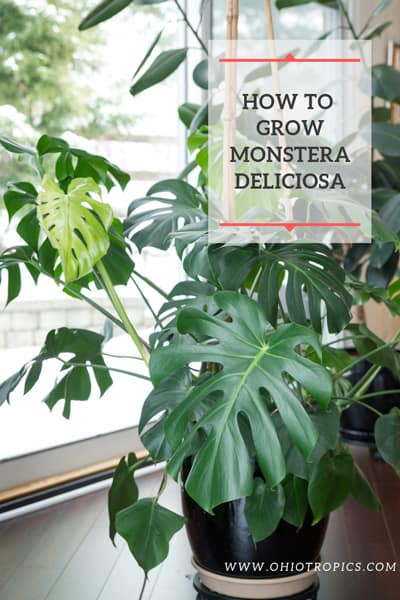
This plant was once popular a few decades ago, and it is back with a vengeance! Monstera deliciosa is one of the trendiest houseplants that you can grow these days.
Not only are they a striking houseplant, but they are also very easy to grow and a fantastic beginner plant! Anyone can grow a Monstera!
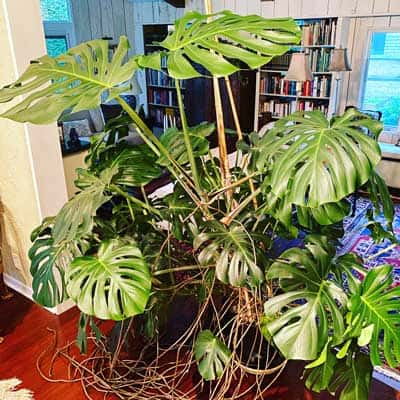
Keep reading to find out exactly how to care for Monstera deliciosa, and also learn about repotting Monstera.
I will also show you how to provide a very sturdy support so your Monstera can climb securely! Forget about the moss posts. I have a much easier and more effective solution.
Table of Contents
About Monstera Deliciosa
There are so many common names for this plant: Swiss Cheese Plant, Mexican Breadfruit, and even Split Leaf Philodendron. Common names are enormously confusing and I always refer to this plant by its botanical name (genus + species), Monstera deliciosa.
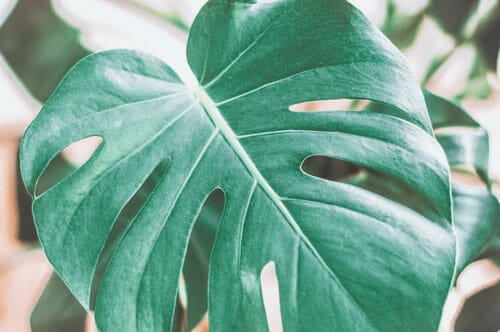
You may be wondering about the botanical name Monstera deliciosa. The genus, Monstera, literally refers to the “monstrous” proportions that this plant takes on in the wild.
The species name, deliciosa, refers to its edible fruit that it commonly produces in the wild. Indoors, you may never see this, but know that it does produce an edible fruit!
These plants hail from tropical regions in the south of Mexico and also parts of Central America and are found growing at the base of trees. They will climb and attach to tree trunks via the aerial roots that they produce.
Monstera Deliciosa Care
1. LIGHT
As you can imagine by how this plant grows in the wild in its natural habitat, as described above, it prefers filtered light, or bright indirect light. I grow mine in a large Eastern exposure window so it received plenty of light, including morning sun which is gentle on the plant.
It can tolerate much darker, low light conditions, but your growth won’t be as spectacular. After all, plants need light to photosynthesize!
You’ll want to avoid too much direct sun however, especially the harsher afternoon sun.
If you live in areas that typically have a lot of strong sun, you’ll want to shield your Monstera deliciosa so that it doesn’t receive too much direct sun.
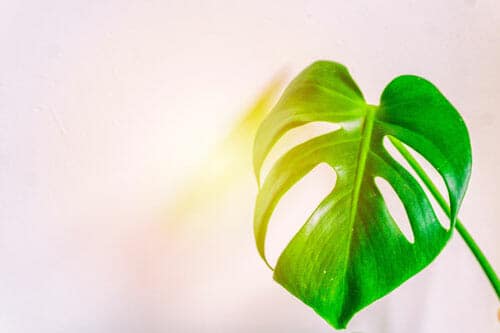
2. WATERING, FERTILIZING & HUMIDITY
Monstera deliciosa is pretty forgiving when it comes to watering. Just like most plants, I like to let the top part of the soil dry out before watering again.
Depending on the size of the pot, I’ll let the top inch or two completely dry out before I water again. Just use your finger to test the soil moisture. Tap water will work just fine.
Mine is growing in a 14 inch pot, so I’ll let the top 2 inches, roughly, dry out before I even think about watering.
Keep in mind that larger pots may take longer to dry out than much smaller pots, so don’t water by your calendar.
Use your finger as your guide! If your Monstera is in a smaller pot, let at least the top inch of the soil dry out before watering again.
Avoid extremes in watering. Never let this plant sit in water otherwise it can easily experience root rot. Always discard any excess water that accumulates in the plant saucer.
On the other hand, try not and let the potting mix completely dry out if you can help it. Find a happy medium!
As far as fertilizing goes, I fertilize my Monstera deliciosa year round except for the winter months.
I sometimes rotate and change fertilizers, but I’m currently using Dyna-Gro Grow for most of my leafy houseplants and I don’t think I’ll ever switch again. This is an AMAZING fertilizer and I stock up on it from Amazon.
I like to fertilize dilutely with every watering. That way my plants receive constant nutrients, similar to how they would grow in nature, and I don’t have to remember the last time I applied fertilizer!
As far as humidity goes, although this plant would appreciate high humidity, it does just fine in my home, even with low humidity during the winter time.
3. LEAF PROGRESSION
One of the most rewarding parts of growing Monstera deliciosa is watching the plant evolve from its juvenile leaves, to the more mature adult leaves.
Young plants have leaves that are completely solid and that have no slits or holes.
As Monstera deliciosa ages, the new leaves will have more and more fenestrations (holes) and slits among the leaves. Keep in mind that after a leaf opens up, it will stay the way it is and will not change.
As the plant matures, the newer leaves will slowly have more and more fenestrations.
Depending on how good your growing conditions are, very young monstera plants may take years indoors before they start to exhibit any fenestrations.
Take a look at the following progression of leaves from my own plant:


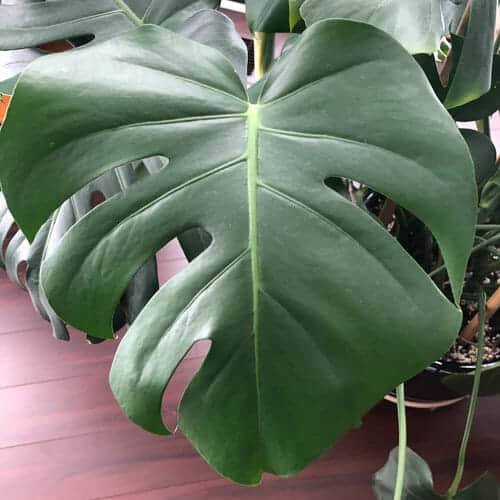

4. Repotting
For some general repotting tips, and knowing when to repot your plant, check out my blog post on repotting.
This post contains many critical aspects of repotting and important steps, so be sure to read up after you’re done reading this Monstera post.
Perhaps the best time of year to repot your plant is early spring when plants are starting to perk up. It can really be done at any time of year if you have good growing conditions. Later winter or early spring is a good bet though.
As I mentioned earlier, Monstera deliciosa is a climbing plant in nature, so you’ll want to add some support, and the perfect time to do this is when you repot your plant!
This way, you will minimize the damage to any roots. Although if you are careful, you can really add support at any time.
After you take your plant out of the pot, be sure to loosen up the root ball a bit. Only choose a larger pot that is 1 or 2 sizes bigger than the current pot. And always use a pot with drainage holes!
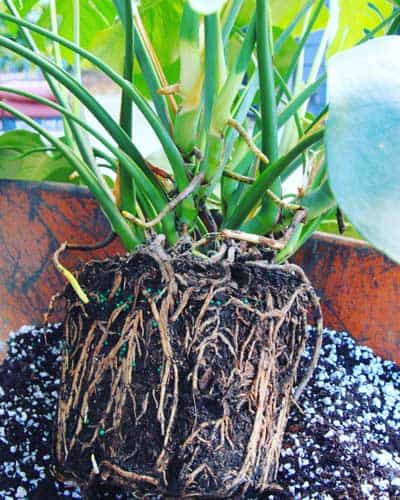
I like to cover the drainage hole with a broken pot shard (placed like an upside down U over the hole, which leaves space on the sides). Some people like to place a piece of old window screening over the hole.
When you repot, this is the perfect time to add a support so that your plant can start climbing!
As the vines grow, you can loosely tie them to the posts.
Take a look at the bamboo tee-pee that I created below.

I simply purchased some bamboo stakes online from Amazon, and put three of them in the pot at the time of repotting. I like to have extras on hand because I also use them in my garden.
Then I simply took some garden twine and tied the top up. It is a very stable structure!
You can also add a moss pole or moss stick when you repot. I wrote a printable, detailed how-to blog post that shows how you can make your own moss post! It’s way better than anything you would buy pre-made and much better quality.
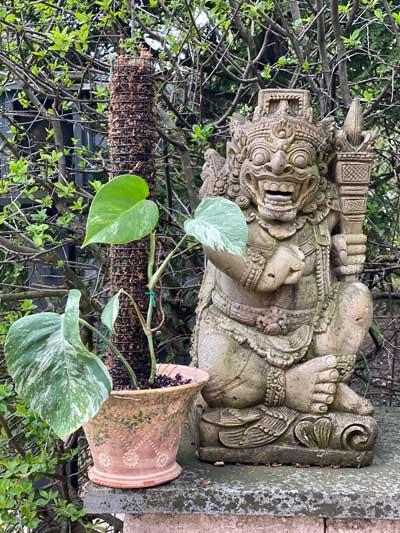
As far as potting media for Monstera deliciosa goes, I like to use a good potting mix, such as Miracle Gro Indoor Potting Mix but I also like to mix in some #3 size perlite.
Use about 1 part of the perlite to 2 parts, or even 3 parts, of the potting soil.
It is a highly sustainable mix, and the owners of the company compost food scraps and add the compost to the mix. I’ve had amazing experiences with this mix and am switching many of my houseplants to this mix (when the time comes to repot).
It already contains plenty of perlite, so there is no need to adjust at all!
I also surveyed my readers to inquire about all their frustrations with potting mixes, and the makers of ‘House’ potting mix answered all these questions and more.
If you want an organic, sustainable, top-quality mix that you can use straight out of the bag, check out my blog post: Oh Happy Plants Potting Mixes.
This will give you a nice airy, nutritious, well draining soil that this plant loves!
If you’re trying to decide what type of pot to give your Monstera, check out my Monstera Pots post that will help you choose the best pot for your plant.
5. Propagating Monstera Deliciosa
Who wouldn’t want more of a good thing? If you want to propagate your Monstera deliciosa, it is very easy to do.
There are a couple of different ways that I will describe to propagate your Monstera deliciosa.
If you are impatient and don’t want to spend too much time, you can simply just cut a vine and place it in water. Not just any old vine though. You’ll want to choose a vine where you see an aerial root.
Then simply just cut below where the aerial root is, near where my finger is in the photo below.

Then simply place this cutting in water. The aerial root will quickly grow in water and it you’ll be able to pot it up in no time at all.
The other method that you can use to propagate your Monstera deliciosa is by air layering. You’ll want to air layer in the exact same spot that I described above (where my finger is in the photo).
For a detailed photo guide, check out my blog post on propagating Monstera in water. The benefit of doing this is that your vine will be much less stressed (versus just cutting it completely off the plant).
You can check out my blog post on air layering houseplants where you can read exactly how to do it! You can do it exactly as described in that post.
Or, alternatively, as long as you choose a vine where you can wrap the sphagnum moss around an existing aerial root, you don’t even have to cut into the vine like I mention in the air layering post.
Simply proceed without cutting because the aerial root will start growing almost immediately.
Other than that one detail, you can follow all the rest of the instructions. Then once it is ready, you can simply cut the vine under where you air layered and pot up your new plant!
Be sure to get everything you need to help your Monstera deliciosa thrive. To summarize, these are the products I talked about in the blog post so you can grow your own gigantic Monstera deliciosa. (Pretty soon, mine will overtake the living room…)
Use 2 or 3 parts Miracle Gro Potting Mix to 1 part #3 perlite. This provides a beautifully airy and well-draining potting mix that these plants just love.
Dyna-Gro Grow is just simply one of the best fertilizers around. Use it regularly on you Monstera deliciosa plant and ALL of your tropicals!
And don’t forget the bamboo stakes to make your tee-pee with. Monsteras need support as they grow.
RELATED POSTS
Also, this is only ONE type of Monstera! There are many other Monstera species. I also grow Monstera adansonii, Monstera siltepecana, and variegated Monstera and I’m in love with those too!
If you want to browse other species of Monstera that you’d like to explore growing, don’t miss my post that includes 15 Amazing Monstera Varieties to add to your collection.
If you have been struggling with growing this plant, check out my related post that will answer your burning questions: Monstera Problems: 11 Frustrating Problems and Solutions.
There is a huge debate on whether you may have a Monstera deliciosa vs. Monstera borsigiana. Be sure not to miss my post on how to tell the difference between the deliciosa vs. borsigiana species.
If you like the look of Monstera deliciosa, but don’t have the room, you can consider growing Rhaphidophora tetrasperma. It is commonly called “mini-monstera” but isn’t actually a Monstera. It does have a similar look, but with smaller leaves.
Be sure not to miss my YouTube video on all my Monstera delciosa growing tips!
FREQUENTLY ASKED QUESTIONS
Why are the leaves on my Monstera turning yellow?
Yellow leaves on your Monstera plant can be caused by a lot of different issues, and this is a very common problem. The causes of yellow leaves can include too little light, too MUCH light, soil that went too dry for too long (which typically results in the lower leaves yellowing), soggy soil, cold temperatures, and more.
For a more detailed explanation so that you can diagnose your individual issue, check out my post on Monstera Yellow Leaves: Top 7 Causes.
Do Monstera plants like humidity?
These tropical plants do appreciate higher humidity levels, but normal room humidity is just fine! You don’t have to invest in a humidifier for your plant. As long as you have proper watering practices and don’t allow your soil to get too dry, average indoor humidity is just fine. Proper watering is far more important than trying to maintain a humid environment for your plant.
For smaller pots, wait to water until the top inch of soil has dried out. For larger pots, say 10 or 12 inches in diameter or more, you can easily allow the top 1-2 inches of soil to dry out before watering again.
Should you use a moisture meter for your plant?
I’ve seen too many people kill their plants by using faulty moisture meters. Many of the inexpensive ones are junky and will read moist, when in fact, your potting mix is bone dry. Save yourself the hassle, and use your finger to judge soil moisture. Wait until the top 1-2 inches of soil have dried out, and then water.
If you’re curious for more details, be sure to read my blog post on the dangers of using soil moisture meters for indoor plants.
I hope you have enjoyed this post on how to care for your Monstera deliciosa.
If you have any questions, please let me know in the comments below and thanks for reading!
Can Monstera recover from spider mites?
Yes, but early detection is key in controlling any pests. You can tell if you have spider mites if you see fine webbing. You’ll also start to see a speckled or mottled appearance on the leaves.
For best results, you’ll want to knock off any existing spider mites with a stream of water, or use a damp cloth to wipe down all the foliage. Then regularly treat with an insecticidal soap or horticultural oil. Check out my post on treating houseplants for spider mites for step by step details.
Do Monstera plants need drainage holes?
Absolutely yes. It is much too risky to grow this plant without drainage holes. The risk of too much water accumulating at the bottom of the pot is too high. And if you’re fertilizing, all the fertilizer salts will accumulate in the pot if you don’t have drainage holes.
Is Monstera deliciosa toxic to animals?
Monstera deliciosa is toxic to cats and dogs, according to the ASPCA, because it contains calcium oxalate.
Does Monstera deliciosa product fruit?
Yes! And it is edible! It needs to be ripe though otherwise it may be painful to eat. Don’t miss my blog post that is all about eating Monstera deliciosa fruit.
I hope you have enjoyed this post on how to care for your Monstera deliciosa.
If you have any questions, please let me know in the comments below and thanks for reading!







Charlotte
Monday 17th of July 2023
I have inherited a very distressed monstera and wondered if you could give me some advice on how to give it a happy life or has it experienced too much stress? All I know is that it was thoroughly under watered, then possibly overwatered as I pulled out a couple of rotten stems. The leaves are browning from early shooting, I’m not sure what to do, it obviously isn’t dead as it keeps shooting, I have photos. I am in the uk.
Raffaele
Monday 17th of July 2023
You can always propagate it and start from scratch :-) I have a post on water propagation: https://www.ohiotropics.com/2023/04/21/how-to-propagate-monstera-in-water/
Sami
Thursday 29th of June 2023
Thanks for the helpful article. I've been wanting a Monstera delisciosa since I moved to my new room and wanted a big showy leafy plant that needed indirect light because I didn't have space to move around a massive plant in front of my windows. I've had my eye on a few etsy shops and kept checking any store I went in that had indoor plants when I found them at Wal-mart a few weeks ago, so excited!! I have always said I have a black thumb with potted plants, in the ground plants I'm fine with. So I was very determined to keep my Monstera alive. My first mistake was not immediately repotting and after a week the leaves had yellow spots even though I hadn't watered at all cuz the soil was still so moist. The Monstera was also sweating, never seen that before! I was afraid I had root rot but it was all good, just had roots trying to escape out the drainage holes. after a few hours reading about every possible problem and possibly solution, I got him repotted by midnight. He's been doing great since, one of the new leaves even unfurled. That same week I rescued a Sansevieria from moving friends so I'm really multiplying my collection quickly. One question I have, is it normal to find yourself petting your Monstera? I even had a bad dream that all his soil got washed away and I couldn't find new soil or pot to fix it. Might have been something to do with the moss pole I've been trying to make once I found all the supplies, which I finally got the moss today. I never thought I would be an indoor plant person, maybe because my mom always liked the spider plants and jade plants whereas I'm drawn to the big and showy floor plants.
Raffaele
Saturday 1st of July 2023
I'm glad you enjoyed my article, and it sounds like you're doing well with your plants Sami! Thanks for commenting, and enjoy your collection!
Heidi
Tuesday 7th of March 2023
Found a monstera type plant by the dumpster it was in pretty bad shape but I've been trying to rescue So any advice is welcome it's finely growing but it still in the pot it would have been bought in so today it's getting a new home
Raffaele
Wednesday 8th of March 2023
Hi Heidi! Really all you can do is give it the routine care that I describe in this post. If I saw a photo, I could maybe make some other recommendations.
Elaine
Tuesday 6th of September 2022
I really enjoyed reading all the info you provided on Monstera plants. When I brought my plant home I discovered spider mites and since it is summer time in NJ I put it outside so it wouldn't affect my other plants and treated it. Now I want to bring it inside. Will the change shock my plant? Should I give it another dose of systemic before bringing it in? Thanks so much for any guidance.
Raffaele
Tuesday 6th of September 2022
Systemics typically don't work with spider mites, but they will work for many other pests. Check out my spider mite blog post https://www.ohiotropics.com/2018/08/12/spider-mites-3-things-you-can-do-to-stop-them/ and also my article on bringing plants back indoors https://www.ohiotropics.com/2019/08/24/controlling-houseplant-pests-bringing-plants-back-indoors/
Amery
Wednesday 20th of July 2022
My monstera has crazy aerial roots happening. What do you do with those? Cut them? Wrap them? Do you have a post on this?
Love the bamboo idea, prettier than the moss poles, those are so intrusive!
Raffaele
Thursday 21st of July 2022
I do have a post on aerial roots! https://www.ohiotropics.com/2021/11/15/monstera-aerial-roots/